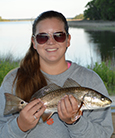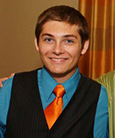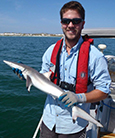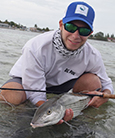Eight graduate students at universities in Florida have received Guy Harvey scholarship awards, recognizing their outstanding achievement in marine science research. The following winners received $5,000 scholarships:
- Chelsey Crandall, University of Florida
- Holden Harris, University of Florida
- Sarah Hoffmann, Florida Atlantic University
- Louis Penrod, Florida Institute of Technology
- James Kilfoil, Florida International University
- Krystan Wilkinson, University of Florida
- Jake Rennert, Florida Institute of Technology
- Julie Vecchio, University of South Florida
The scholarship, established in 2010 through a partnership between Florida Sea Grant and the Guy Harvey Ocean Foundation, recognizes students at Florida universities whose research focuses on the biology, ecology, habitat or management of fish in Florida’s marine environment. Since the award was established, $164,000 in scholarships has now been given to 35 students at nine different Florida universities.
Recipients also receive a certificate designed and signed by well-known marine wildlife artist and conservationist Guy Harvey. Thus far, awards have been given to students at the University of Florida, Florida State University, University of Central Florida, University of South Florida, University of Miami, University of North Florida, Florida Atlantic University, Florida International University and the Florida Institute of Technology.
“The recipients of the scholarship are the best and brightest of Florida’s college students who are conducting research dealing with marine fish or fisheries management issues,” said Karl Havens, director of Florida Sea Grant.
Greg Jacoski, director of the Guy Harvey Ocean Foundation, agreed. “We are delighted that this scholarship program is having such an impact, both in regard to supporting Florida college students and in supporting important research projects,” Jacoski said. “The partnership with Florida Sea Grant has been good for us, and good for aspiring marine science students and our oceans.”
This year’s research projects range from developing new tools for resource monitoring programs to investigating predator-prey relationships between dolphins and sharks.

Chelsey Crandall
Chelsey Crandall, a Ph.D. in interdisciplinary ecology in the University of Florida’s School of Natural Resources and Environment, is using social science methods to understand how anglers and others connected with fishing in the state interact with fisheries management and science.
With a background in fisheries science, Crandall says her dissertation work has helped her learn a whole new set of skills.
“Social science methodology was new to me,” Crandall said. “But I hit the ground running and have learned how to survey and interview Florida’s fishermen.”
Crandall, who was a recipient of the 2014 Florida Outdoor Writers Association Scholarship, is also a proponent of effective science communication. She regularly contributes to the Florida Fisheries Science blog, and is the cofounder of Ocypode Productions, where she has helped create two films and three educational shorts to date.
When she graduates, Crandall hopes to remain in Florida and in academia with the goal of becoming a professor.
“Florida is a particularly special place and I wanted to devote my career to protecting it,” Crandall said.

Holden Harris
Holden Harris, a Ph.D. student in interdisciplinary ecology at the University of Florida’s School of Natural Resources and the Environment, is evaluating whether a commercial fishery can function as a long-term control for the invasive lionfish.
“A market-based system of incentivizing their harvest may offer opportunities to mitigate the negative impacts of lionfish while simultaneously increasing the quantity, quality and diversity of seafood production,” Harris said. “At the same time, establishing a commercial fishery for a marine stock we are specifically trying to overfish has never been undertaken.”
Harris is also conducting research at the UF’s new Nature Coast Biological Station to develop management plans for the Big Bend region’s most important recreational fish species, spotted seatrout.
Micheal Allen, director of the Nature Coast Biological Station, and Harris’ adviser, said he recommended Harris for the award because of his ability to involve the public while answering tough research questions.
“He has obtained experience working in nearly all aspects of marine systems including tourism as a snorkel boat operator in the Florida Keys, work as a commercial spearfisherman, a Scuba instructor, and a marine science instructor,” Allen said. “I believe that Holden is uniquely positioned to make an impact in our field because he understands that science cannot operate in a vacuum.”
Ultimately, Harris hopes to continue to be involved in fisheries management in his budding career.

Sarah Hoffmann
Sarah Hoffmann, a Ph.D. student in integrative biology at Florida Atlantic University, is investigating the interaction among ecology, function and morphology, or form and structure, of the head and pectoral fins across many shark species.
“For example, benthic species, such as a white-spotted bamboo shark, have flexible pectoral fins that are used to dig and burrow, whereas pelagic species, such as thresher sharks, have broad, stiff pectoral fins that look like airplane wings and may lack the same maneuverability,” Hoffmann said. “By investigating the morphology, movement, and muscular control across many shark species, we will gain insight into the ecomorphology of the head and pectoral fins in sharks.”
Hoffman, who has worked on research projects with the National Marine Fisheries Service, the Florida Fish and Wildlife Conservation Commission and the American Fisheries Society, grew up in land-locked Idaho. But, as an undergraduate researcher at Clemson University, she was able to spend her summers in the Florida Keys.
“It only took a couple trips out on those pristine waters to convince me what I wanted to do with my life,” Hoffman said.
Although she has no specific career goal in mind yet, she is certain she wants a job that allows her the freedom to explore original research questions in her field.

Louis Penrod
Louis Penrod, an undergraduate studying marine biology and aquaculture at the Florida Institute of Technology, is researching the feeding patterns of the invasive lionfish in a range of habitats and water temperatures.
“This allows us to look at how the lionfish can easily capture its prey no matter where they live,” Penrod said. “But also, it lets us predict how that may be altered as the oceans warm due to global climate change.”
Ralph Turingan, a professor of marine biology at FIT, said Penrod is one of the most outstanding undergraduates in his lab.
“His motivation to learn how to conduct research and address climate-change relevant questions at an early stage in his undergraduate program was truly impressive,” Turingan said. “His research potentially contributes to our current effort to find ways to effectively eradicate lionfish populations.”
Although Penrod is sure he wants to work as a marine scientist, he is still keeping his options open for his specific career goals. He says his “grand plans” after graduate school involve designing and building a sustainable aquaculture facility.
“One day, I would like to share what I’ve learned by teaching at the collegiate level specifically focusing on fisheries, ecomorphology and biometry,” Penrod said.
 James Kilfoil, a Ph.D. student in biological science at Florida International University, is exploring how tools, such as video surveys, could improve the way data is collected for resource monitoring programs. He believes these tools will be particularly important for monitoring elasmobranch species such as sharks and stingrays.
James Kilfoil, a Ph.D. student in biological science at Florida International University, is exploring how tools, such as video surveys, could improve the way data is collected for resource monitoring programs. He believes these tools will be particularly important for monitoring elasmobranch species such as sharks and stingrays.
“Nearly half of all elasmobranch species are data deficient, meaning we lack even the most basic information needed for their proper management,” said Kilfoil, who is working under the direction of FIU assistant professor of marine science, Yuying Zhang. “I intend to investigate how these video surveys compare to traditional methods, how accurately they track changes in abundance, and how environmental variables and animal behavior may influence detection rates.”
Michael Heithaus, a professor in the department of biological sciences at FIU, said Kilfoil’s research is proving valuable information to his lab.
“This study is providing us with new insights as to the population status and ecological role of two dominant shark species,” Heithaus said. “He will provide data from important regions that will help us understand the relationships between shark counts from video surveys and relative and absolute densities of sharks.”
Kilfoil plans to pursue a research career in academia or for an agency like NOAA once he graduates.

Krystan Wilkinson
Krystan Wilkinson, a Ph.D. student in the School of Natural Resources and Environment at the University of Florida, is investigating predator-prey interactions between sharks and bottlenose dolphins in Sarasota Bay. Part of her research will involve tagging and tracking adult bull sharks.
“The information collected will be integrated with information of dolphin habitat use, movement, survival and behavior to better understand and quantify these inter-species interactions, identify behavioral decisions made by prey species, and fill important data gaps regarding habitat requirements for coastal shark species,” said Wilkinson, who is also a researcher with the Chicago Zoological Society and is based at Mote Marine Laboratory.
Wilkinson said this research is a continuation of her master’s research, which she also conducted at the University of Florida in the Department of Wildlife Ecology and Conservation. Results from her thesis work are currently being submitted for publication.
“For a student with limited research funding, this demonstrates how Ms. Wilkinson seeks out opportunities for learning, writing and publications wherever possible to advance her skillset and knowledge of marine ecology,” said her adviser, William Pine, associate professor in UF’s Department of Wildlife Ecology and Conservation.
Wilkinson, who first was inspired to be a marine scientist in third grade after reading Ann McGovern’s book about Eugenie Clark, Shark Lady, hopes to pursue a research career with a nonprofit or government agency.
“I hope to broaden outreach capacity and engage the public in ocean conservation initiatives,” Wilkinson said.

Jake Rennert
Jake Rennert, a master’s student in marine biology at the Florida Institute of Technology, is researching the age and growth patterns of bonefish in various habitats around the island of Cuba.
“My thesis will evaluate some of the proposed mechanisms behind the very different growth rates and ages-at-maturity of this treasured sport fish in Florida, the Bahamas, and other locations,” Rennert said.
Rennert said he was inspired to conduct this research because of his long-term love of fly fishing. He said he was taught at a young age to understand the responsibility of conservation. His career goal is to become a lead biologist for the National Marine Fisheries Service.
“My strive to better understand fishes and passion for the ocean complement each other perfectly in my chosen career as a fisheries biologist,” Rennert said. “My main motivation for participating in fisheries research is to give future generations the same experiences I had.”
Jonathan Shenker, an associate professor of marine biology and aquaculture at FIT, said Rennert’s research is not only relevant, but could potentially help future U.S.-Cuba research collaborations.
“I think this work will also serve a valuable template for increasing cooperation among U.S. and Cuban fisheries researchers who strive for better management of our valuable fisheries resources,” he said.

Julie Vecchio
Julie Vecchio, a Ph.D. student in marine science at the University of South Florida, is using natural tags, or chemical signatures within the tissues of fish, to understand the movements and food preferences of fish over their lifetime.
“The eye lenses are particularly useful because they leave a record over the entire lifespan of the fish,” Vecchio said. “This is important because it can help us to understand specific habitat requirements for fish, providing direction for potential marine protected areas and other conservation measures.”
Vecchio describes herself as a “nontraditional” student, noting how she took time off between degrees to work in her field.
She has previously worked as a research assistant for the South Carolina Department of Natural Resources, a research associate for the Florida Fish and Wildlife Conservation Commission and as a contract video technician for NOAA Fisheries. From 1999-2002, she also worked as an educator for various marine science camps.
“If there’s one piece of advice I have for younger people, it’s this: don’t think you have to get all of your education at once. There’s a lot of value in getting a variety of work experiences mixed in with your education.” Vecchio said. “I hope to continue to incorporate new techniques into our understanding of marine fishes while mentoring the next generation of marine scientists.”
The Guy Harvey Ocean Foundation is an organization of philanthropists, conservationists, scientists and educators that emphasizes sensible strategies for promoting ocean conservation and the development of the next generation of marine scientists. The foundation funds research and educational programs developed by universities, colleges, institutes and nonprofit organizations. Learn more about the Guy Harvey Scholarships winners on our Current Fellows page, or learn more about the scholarship itself.



